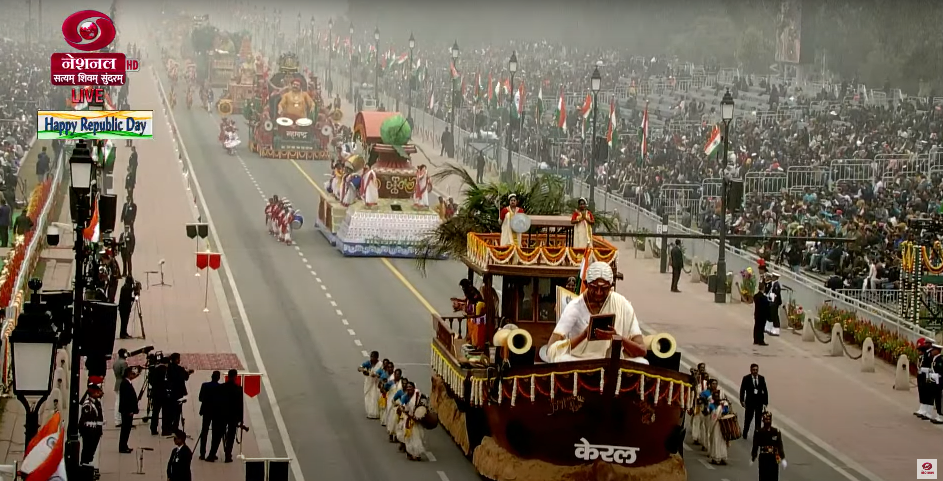 Dispatches
DispatchesIndian law students are reporting for JURIST on law-related developments in and affecting India. This dispatch is from Samar Veer, a third-year law student at National Law University, Delhi.
India Thursday marked 74 years since the adoption of its Constitution. In line with longstanding tradition, Republic Day celebrations started off with a parade showcasing the nation’s military prowess and rich cultural diversity on full display at the newly rechristened “Kartavya Path” (which roughly means ‘Boulevard of Duty’), formerly named “Raj Path” (King’s Boulevard). The seven-day celebrations commenced on January 23rd, the birth anniversary of Indian freedom fighter Subhas Chandra Bose, which is celebrated as “Parakram Diwas” (‘Day of Valour’) and will culminate on January 30th, observed as Martyrs’ Day, the day on which Mahatma Gandhi was assassinated.
This year, the President of Egypt, Abdul Fattah El-Sisi, arrived from Cairo to witness the annual ceremony as the Guest of Honour. Traditionally, the Guest of Honour is escorted to the venue by the President of India, who is also the Supreme Commander of the Indian Armed Forces. This year, the newly-appointed President Draupadi Murmu performed the honours on behalf of the state. Notably, a combined band and marching contingent of the Egyptian Army also took part in the annual ceremony on Kartavya Path.
The theme adopted by the Government of India this year was “Atmanirbhar Bharat” (“self-reliant India”), which has been the primary slogan of the Indian government for several years, reflective of their signature policy to introduce greater self-reliance in Indian trade and industry, by reducing foreign imports and promoting indigenous manufacturing initiatives. Keeping this in mind, most of the weaponry and technology showcased at this year’s event was of Indian origin. Even the traditional 21-gun salute, given during the playing of the Indian national anthem, consisted entirely of Indian-made 105mm field guns. The co-theme for this year’s event was “Nari Shakti” (roughly meaning ‘women empowerment’). Many contingents of the armed forces this year were composed of women participants, most notably including the Indian Navy’s contingent of 144 sailors led by Lt. Commander Disha Amrith and the Central Reserve Police Force’s (CRPF) contingent led by Asst. Commandant Poonam Gupta. Notably, soldiers recruited through the recently introduced and hotly debated “Agniveer” recruitment scheme of the Central Government also took part in the march on Kartavya Path.
A total of 24 tableaux (“floats”), including 17 from India’s states and 6 from various government ministries and departments, graced the boulevard. This was the first time the Narcotics Control Bureau (NCB), a law enforcement agency under the Ministry of Home Affairs tasked with combating drug trafficking and distribution, presented a tableau at the annual ceremony.
The President of India, Draupadi Murmu, hailed the spirit of India’s constitution a few days ago, commending the diverse range of ideas that went into its making, along with applauding how it had endured countless challenges over seven decades and still prevailed by constantly evolving and adapting to reflect the changing needs of the people. This endorsement of the Constitution is certainly of great importance in the current scenario, owing to the ongoing row between the Indian government and judiciary regarding judicial appointments, along with questions raised by various notable figures, including the Vice President of India Jagdeep Dhankar himself, on whether the executive or judiciary was supreme. In any functional democracy that has not fallen prey to the will of the individual leaders and is led by the law, it is plain to understand that such a democracy would consider its collectively drafted law, i.e. its Constitution, to be supreme and not any person or institution.
It is also of some interest to note how the NCB presented a tableau at the Republic Day parade for the first time. Not very long ago, the NCB was the primary investigating agency of a widely-reported and sensationalized drug scandal involving the son of Bollywood megastar Shah Rukh Khan. The case had raised some serious privacy concerns as WhatsApp chats between private persons were communicated between departments and widely circulated by media outlets.
The theme of “Atmanirbhar Bharat” seems to reflect an official commitment to ensuring India’s self-reliance in manufacturing and industry. However, even with the message and the successes, such as increased defence exports in recent years, there is still a long way to go. On the other hand, seeing the eager participation of women as equals to their male counterparts in the annual ceremony is a welcome development. It is another symbolic victory for women’s inclusion in the armed forces, after the Supreme Court’s landmark verdict just a few years ago on commissioning women officers into the military. The debate on women’s roles in the military, however, is still not over. For instance, the inclusion of women in full combat roles is also something that has been much talked about over the years. Like any other institution, the military of a nation is also reflective of the society that constitutes it. Though, the commissioning of women into the military as officers is a steady step in the right direction, the introduction of women into a respected paramilitary force like the Assam Rifles in ranks below the level of officers, is subtly indicative of how the steep climb for fully gender-equal policies in the Indian military has just begun.
The Republic Day ceremony this year was jubilant as always, but it was against the backdrop of a controversy-laden year with disputes within the government, concerns over democratic erosion and hyper-nationalism galore. The endorsement of the constitution and the emphasis on its will to live on as the supreme law that shall govern the people and never be subservient to anyone is a symbolic glimmer of hope that India’s concerns over the state of its democracy will be ameliorated in time and the Republic will prevail.

